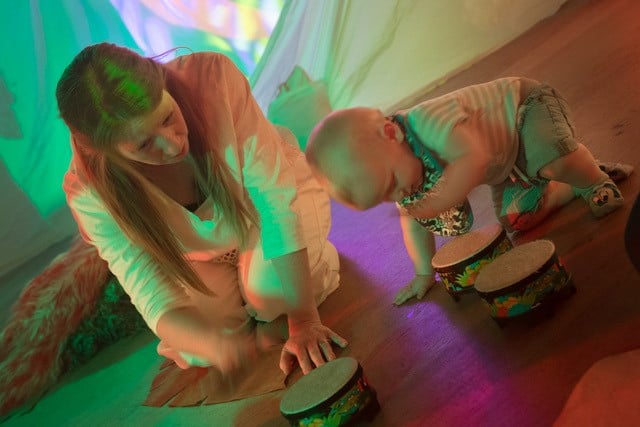
Anything can happen with toddlers
Photo: Magic Adventure
The improvisation experts
Why do some in the sector feel that babies and toddlers have little to offer as audiences or participants? On the contrary, says Charlotte Arculus, working with this group is never boring.
I have been working with very young children for over 30 years and whatever you think is going to happen won’t – young children will confound you, so never underestimate them. If you can roll with this, if you are a good improviser and open to new and unexpected things, then they will surprise and delight you.
Despite what our education system currently does, the purpose of being a child is not to become an adult as quickly as possible
I am keen for the arts sector to recognise that this work is uniquely skilled. In her TED talk Alison Gopnik proposes that: “Babies and young children are like the research and development division of the human species.” This statement not only raises the importance of this age, it offers the potential of a creative exploration between young children and those artists who encounter them.
It is never boring, and my young co-creators constantly take me to new places. I am a performing artist with a background in community music and street theatre, with a particular interest in improvisation. And to keep this practice sharp, I work with the improvisation experts – toddlers and babies.
Important stage of development
As part of the Magic Acorns artists collective (which has grown out of the Priory Childrens Centre Arts practice), I have been working with Festival Bridge to make the early years matter to leaders and funders.
Sadly, I sometimes find a profound lack of interest in young children, an assumption that they have nothing to offer as audiences for (or participants in) arts activity, and therefore are not worth the investment. Despite what our education system currently does, the purpose of being a child is not to become an adult as quickly as possible, and each stage of development is important and valid in its own right.
Therefore, arts practices for young children cannot be scaled-down versions of work with older children. This age group requires a very particular and specialised approach. Crucially, creative spaces for young children are not about pre-determined learning outcomes (whatever you think will happen invariably won’t), but happenings will certainly take place. An early years arts practice involves not knowing where things are going, and embracing that not-knowing.
A discerning audience
Can babies and toddlers actually be discerning audiences? I can only say, try engaging with them, holding their attention or having a sustained conversation through facial expression, voice play, journeying or movement. Because a good early years artist will do just that, beautifully, and if you can engage very young children, you can engage anyone.
Babies and toddlers understand the foundations of unadulterated, intensive interaction. They are the most discerning audiences and I think there is a political and ethical imperative to be creating the most exquisite work for them.
Observation and co-creation
The cultural sector’s early years offer is variable and disparate, but there is some amazing work out there. I would advise anyone wanting to develop this area of work to seek partnerships with experienced arts practitioners with track records and avoid franchises that promise the world and deliver a one-size-fits-all template. Spend time observing the practices of experienced early years artists and ask lots of questions. And if possible, hang out with actual children, initiate nothing for a long time, see what occurs and eventually introduce something that interests you and see what they do with it. Try to learn what is happening in other countries.
A key factor for me is not relying on words and talking. I try not to talk at all in my own practices. Giving directions and expecting toddlers and babies to follow them won’t work, nor will they sit and passively watch. Creative work has to be much more interesting than that.
An experienced early years artist co-creates with children, multi-modally – through combinations of movement, gesture, voice play, object play, mark-making, musicing, funniness and so on. They will work with children through their many and varied communicative modes rather than trying to dominate by talking. This requires tuning into children and spending open-ended, improvised time with them, working in abstract ways where anything can happen.
I have learned to keep the groups I work with small – no more than 12 children. There are always adults who accompany young children, parents or practitioners, so making art with young children means doing it with those who care for them too – parents, grandparents, practitioners and childminders.
Being able to gain the trust and confidence of those adults and get them on board is crucial. I have found there is often fear and lack of confidence around both the arts and being a parent, so an early childhood artist needs to hold the creative space for adults as well as children.
A visible world
My next project is a doctoral research project that will explore arts practices with two-year-old children where adults stop talking. Features of this research will include the use of film, child-operated video cameras and interactive projection as a way of documenting what happens. My aim is to co-create research with children through video so that their worlds become visible and to advocate the idea that being two years old comes with a set of non-word-based knowledge and understanding that is highly valuable and worth deep consideration.
Charlotte Arculus is the Creative Director of Magic Adventure.
https://www.magic-adventure.co.uk
Join the Discussion
You must be logged in to post a comment.